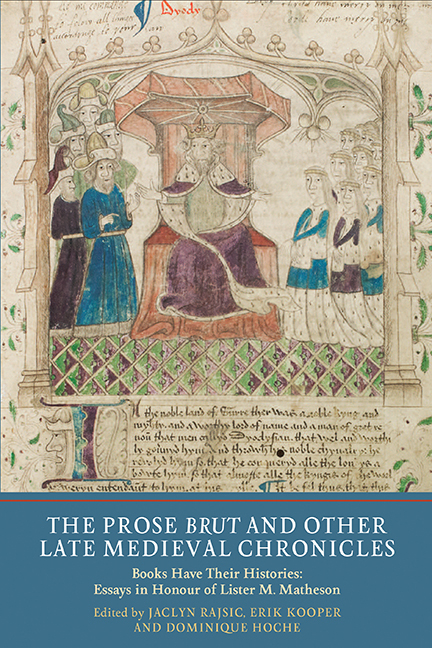 The Prose Brut and Other Late Medieval Chronicles
The Prose Brut and Other Late Medieval Chronicles Book contents
- Frontmatter
- Dedication
- Contents
- List of Plates
- List of Contributors
- Acknowledgements
- Curriculum Vitae of Lister M. Matheson
- Introduction
- A Memoir: The Whole Haggis: Lessons From the Work of Lister M. Matheson
- Part I Uses of History
- Part II The Prose Brut
- 5 Longleat House MS 55: An Unacknowledged Brut Manuscript?
- 6 Peculiar Versions of the Middle English Prose Brut and Textual Archaeology
- 7 The English Prose Brut Chronicle on a Roll: Cambridge, Corpus Christi College, MS 546 and its History
- 8 Re-Printing or Remaking? The Early Printed Editions of the Chronicles of England
- Part III Receptions and Afterlives of Late Medieval Chronicles
- Index of Manuscripts Cited
- General Index
- Tabula in Memoriam
8 - Re-Printing or Remaking? The Early Printed Editions of the Chronicles of England
from Part II - The Prose Brut
Published online by Cambridge University Press: 05 July 2016
- Frontmatter
- Dedication
- Contents
- List of Plates
- List of Contributors
- Acknowledgements
- Curriculum Vitae of Lister M. Matheson
- Introduction
- A Memoir: The Whole Haggis: Lessons From the Work of Lister M. Matheson
- Part I Uses of History
- Part II The Prose Brut
- 5 Longleat House MS 55: An Unacknowledged Brut Manuscript?
- 6 Peculiar Versions of the Middle English Prose Brut and Textual Archaeology
- 7 The English Prose Brut Chronicle on a Roll: Cambridge, Corpus Christi College, MS 546 and its History
- 8 Re-Printing or Remaking? The Early Printed Editions of the Chronicles of England
- Part III Receptions and Afterlives of Late Medieval Chronicles
- Index of Manuscripts Cited
- General Index
- Tabula in Memoriam
Summary
LISTER Matheson will be best remembered and most sorely missed for his work describing and categorizing the manuscripts of the Middle English Prose Brut chronicle (hereafter Brut), work thath not only facilitated systematic scholarly study of the many different Brut manuscripts but that also broke new ground in tracing the activities of the scribes who produced them. In the eyes of earlier historians studying the fifteenth century, the Brut's ubiquity had been its sole notable feature. The anonymous Brut took as its starting point the legendary line of British kings from Brutus to Cadwallader, first set in writing by Geoffrey of Monmouth, and extended the narrative through the succession of Saxon, Norman and Angevin kings, abbreviating or excising graphic details about the deeds of the early Britons and drawing heavily on vernacular adaptations of Geoffrey's Historia, as well as other English and Anglo-Norman histories, for its continuations. The brevity of the Brut's narrative, combined with its reliance on Geoffrey of Monmouth's legendary history of Britain, not only diminished its worth in the eyes of some early twentiethcentury scholars, but also made it difficult to distinguish Brut manuscripts from copies of other chronicles and histories of the time, which shared a similar scope and common subject matter. By carefully considering the Brut's textual variations and adaptations, Matheson breathed life into the study of a kind of historical writing that had been considered prolific but uninspired, dry and derivative. This essay will attempt to invigorate another aspect of the Brut tradition: its printed editions. In order for scholars to fully assess the social and historical impact of the Brut, the printed editions of the chronicle must be considered alongside its manuscripts.
Thus far, the only printed edition of the Brut to receive significant scholarly comment has been the first one, which was produced by William Caxton on 10 June 1480 under the title The Chronicles of England. Caxton's printed Chronicles was notable for being the first English vernacular history to appear in print, and also for containing a continuation of the history from 1419 down to ‘the beginnyng of the regne of our said soverain lord kyng Edward the iiij’ (i.e., to 1461), which was incorporated into all subsequent printed editions, both by Caxton and by others.
- Type
- Chapter
- Information
- The Prose Brut and Other Late Medieval ChroniclesBooks have their Histories. Essays in Honour of Lister M. Matheson, pp. 125 - 146Publisher: Boydell & BrewerPrint publication year: 2016
